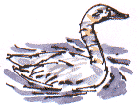 A SHORT RIVERBANK WALK links two very different worlds, from Georgian, stone-built, Heath village we pass the former site of Wakefield's power station, which is still an expanse of rubble.
A SHORT RIVERBANK WALK links two very different worlds, from Georgian, stone-built, Heath village we pass the former site of Wakefield's power station, which is still an expanse of rubble.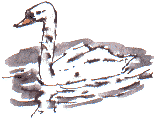 Two Mute Swan cygnets are still in adolescent plumage but I imagine the resident pair of adults will soon see them off. Sunlight reflected from ripples projects faint golden collars which glide up their long necks.
Two Mute Swan cygnets are still in adolescent plumage but I imagine the resident pair of adults will soon see them off. Sunlight reflected from ripples projects faint golden collars which glide up their long necks. Stone built warehouses some 200 years old and brick-built mills reminiscent of Lowry stand at Thornes canal basin, ripe for conversion. The title ARTS MILL, spelt in large day-glow capitals stuck in the upper storey windows of a mill, shows the way things are going. If I'm going to sketch this area to capture its original character, I'd better start soon.
Stone built warehouses some 200 years old and brick-built mills reminiscent of Lowry stand at Thornes canal basin, ripe for conversion. The title ARTS MILL, spelt in large day-glow capitals stuck in the upper storey windows of a mill, shows the way things are going. If I'm going to sketch this area to capture its original character, I'd better start soon.
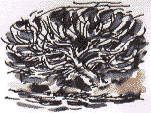 Near the 14th century Chantry Chapel, a large Fig grows on the south-facing bank of the river, just below the outlet of a beck which, thanks to its effluent, once provided the warmth which enabled the seed, which itself arrived in the effluent, to germinate. Similar conditions in Sheffield have made the River Don famous for its fig trees.
Near the 14th century Chantry Chapel, a large Fig grows on the south-facing bank of the river, just below the outlet of a beck which, thanks to its effluent, once provided the warmth which enabled the seed, which itself arrived in the effluent, to germinate. Similar conditions in Sheffield have made the River Don famous for its fig trees. We cross a packhorse bridge of 1730 to a grassy stretch of riverbank with plenty of Alders. Their bark has prominent pores or lenticles so these are planted Grey Alders, introduced from Europe, rather than the native Common Alder (now there's something I wouldn't have learnt if I hadn't been compiling this nature diary).
We cross a packhorse bridge of 1730 to a grassy stretch of riverbank with plenty of Alders. Their bark has prominent pores or lenticles so these are planted Grey Alders, introduced from Europe, rather than the native Common Alder (now there's something I wouldn't have learnt if I hadn't been compiling this nature diary).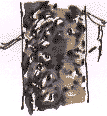
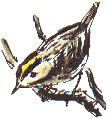 We disturb a charm of 8 Goldfinches and watch a Goldcrest, a bird that appears smaller than our Wren, meticulously searching the branched of an Elder.
We disturb a charm of 8 Goldfinches and watch a Goldcrest, a bird that appears smaller than our Wren, meticulously searching the branched of an Elder.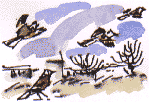
Richard Bell,
wildlife illustrator
E-mail;'richard@daelnet.co.uk'